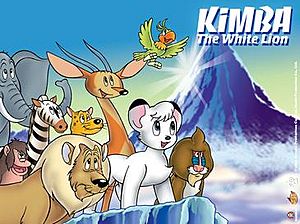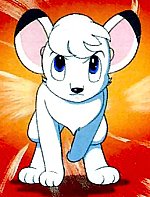Kimba the White Lion facts for kids
| Kimba the White Lion | |

Artwork from the Kimba Ultra Edition DVD set.
|
|
Quick facts for kids ジャングル大帝(Janguru Taitei) |
|
|---|---|
| Manga | |
| Written by | Osamu Tezuka |
| Published by | Gakudosha Kobunsha Kodansha |
| Demographic | Shōnen |
| Magazine | Manga Shōnen |
| Original run | November 1950 – April 1954 |
| Volumes | 3 |
| Anime television series | |
| Directed by | Eiichi Yamamoto |
| Music by | Isao Tomita Toriro Miki (theme song) |
| Studio | Mushi Production |
| Licensed by | |
| Network | Fuji TV |
| English network | |
| Original run | October 6, 1965 – September 28, 1966 |
| Episodes | 52 |
| Anime film | |
| Directed by | Eiichi Yamamoto |
| Studio | Mushi Production |
| Released | July 31, 1966 |
| Runtime | 74 minutes |
| Anime television series | |
|
|
| Anime television series | |
|
|
| Original video animation | |
| Jungle Emperor Leo: Symphonic Poem | |
| Directed by | Toshio Hirata |
| Music by | Isao Tomita |
| Studio | Madhouse Tezuka Productions |
| Released | 1991 |
| Runtime | 51 minutes |
| Anime film | |
|
|
| Anime film | |
| Jungle Emperor Leo: Hon-o-ji | |
| Directed by | Fumihiro Yoshimura |
| Produced by | Minoru Kubota |
| Written by | Mayumi Morita |
| Studio | Beijing Sharaku Art Media.Vision |
| Released | March 18, 2000 |
| Runtime | 9 minutes |
| Anime television film | |
| Jungle Taitei: Yūki ga Mirai wo Kaeru | |
| Directed by | Gorō Taniguchi |
| Written by | Osamu Suzuki |
| Music by | Takefumi Haketa |
| Studio | Tezuka Productions |
| Licensed by | |
| Network | Fuji TV |
| Released | September 5, 2009 |
| Runtime | 96 minutes |
Kimba the White Lion is a famous Japanese story. In Japan, it is known as Jungle Emperor (ジャングル大帝, Janguru Taitei). It started as a manga (Japanese comic book series) written by Osamu Tezuka. The manga was published from 1950 to 1954.
Later, an anime (Japanese animated show) was made based on the manga. This anime was created by Mushi Production and first aired in Japan in 1965. It was a very special show because it was the first color animated TV series ever made in Japan! It also came to North America starting in 1966. Other versions of the series were later made by Tezuka Productions.
In 2009, a special TV movie was released. It was made to celebrate Fuji TV's 50th anniversary. This movie had a new story and cool character designs.
Story of Kimba the White Lion
The story of Kimba the White Lion takes place in Africa. It is set in the middle of the 20th century.
Panja, the Brave White Lion
A brave white lion named Panja (called Caesar in the English version) is the leader of the jungle. He creates a safe place for all the wild animals. Panja helps the jungle animals by finding food for them. This sometimes makes the nearby villagers upset.
A professional hunter named Ham Egg (Viper Snakely in English) is hired to stop Panja. Instead of fighting Panja directly, Ham Egg uses a trick. He records Panja's sounds to trap Panja's pregnant mate, Eliza. Eliza is then used as bait to catch Panja.
Panja is sadly killed for his fur. But before he dies, he asks Eliza to name their future child Kimba. Eliza is then put on a ship that is going to a zoo.
Kimba's Journey Home
Kimba (named Leo in Japanese) is born on the ship. His mother, Eliza, teaches him about his father's ideas of peace and helping others. As a big tropical storm approaches, Eliza helps Kimba escape from her cage.
The storm wrecks the ship, and Kimba starts to drown in the ocean. Friendly fish help him learn how to swim. When he feels like giving up, the stars in the sky form his mother's face. She encourages him to keep going. Guided by butterflies, Kimba finally reaches land.
Kimba lands far from his home jungle. Some kind people find him and take care of him. He learns many good things from humans. He decides that when he returns to the jungle, he will bring these good ideas to the animals. He wants to create a peaceful home, just like his father.
The show follows Kimba as he returns to the wild. He is still a young cub. The story shows how he learns and grows over the next year. Kimba discovers that true peace comes from animals and humans understanding each other.
Kimba in Media
Kimba the White Lion has appeared in many forms. This includes manga, TV shows, and movies.
Manga Series
The original Jungle Emperor story began in 1950. It was published in a magazine called Manga Shōnen.
One of the manga books has been released in two languages. It is called Jungle Emperor Leo – Leo Edition. It has both Japanese and English text.
Anime Series and Films
The First TV Series (1965)
The first animated TV series aired in Japan from October 1965 to September 1966. It was shown on Fuji Television. This was a very important show because it was the first color TV anime series ever made!
The series was shown in many countries around the world. It was broadcast in parts of Asia, Europe, North America, and Oceania. In North America, it was first shown in 1966 with English voices. The voice of Kimba was done by Billie Lou Watt. Later, in 1993, the series was re-dubbed with new voices.
The 1966 Film
A movie version of Jungle Emperor was released in Japan on July 31, 1966. It was directed by Eiichi Yamamoto.
The Sequel Series (1966)
A follow-up series called Jungle Taitei: Susume Leo! aired in Japan from 1966 to 1968. In this series, Leo (Kimba) is an adult lion. It was shown in the United States in 1984 as Leo the Lion.
The 1989 Remake Series
In 1989, a new version of Jungle Emperor was made. It was called The New Adventures of Kimba The White Lion. This series had a very different story and characters. Some parts of it were released on video in English in 1998.
The 1997 Film
A new Jungle Taitei movie, Jungle Emperor Leo, came out in Japan in 1997. This film was based on the second part of Osamu Tezuka's original manga. It was released on DVD in English in 2003.
The 2009 TV Film
A TV movie called Jungle Taitei – Yūki ga Mirai wo Kaeru (ジャングル大帝 勇気が未来をかえる) aired in Japan in 2009. It had a brand new story. The setting was an artificial jungle in the future. In this movie, Kimba's parents, Panja and Eliza, are still alive.
Other Media
There were plans for video games based on Jungle Emperor. A game for the Nintendo Entertainment System was planned for 1990 but was cancelled. Another game for the Nintendo 64 was also planned but never released.
Characters from Jungle Emperor have also appeared in other media. They made small appearances in the Game Boy Advance game Astro Boy: Omega Factor. They also showed up in a chapter of the Black Jack manga. You can also see them in the Fringe TV series.
Music
The Kimba the White Lion series has several theme songs.
Japanese Themes
The original 1966 Japanese TV series has an opening song called "Jungle-Taitei" (ジャングル大帝, Janguru-Taitei, "Jungle Emperor"). The ending song is "Leo no Uta" (レオのうた, Reo no Uta, "Leo's Song").
For the 1989 Japanese remake, the opening song is "Savanna o Koete" (サバンナを越えて, Sabanna wo Koete, "Past the Savanna"). The ending song is "Yūbae ni Nare" (夕映えになれ).
English Themes
The American theme song for the first series was written by Bernie Baum, Bill Giant, and Florence Kaye. It was sung by Bill Giant.
The sequel series had an opening song called "Go Ahead Onward Leo!". This song was written by Isao Tomita.
See also
 In Spanish: Jungle Taitei para niños
In Spanish: Jungle Taitei para niños


